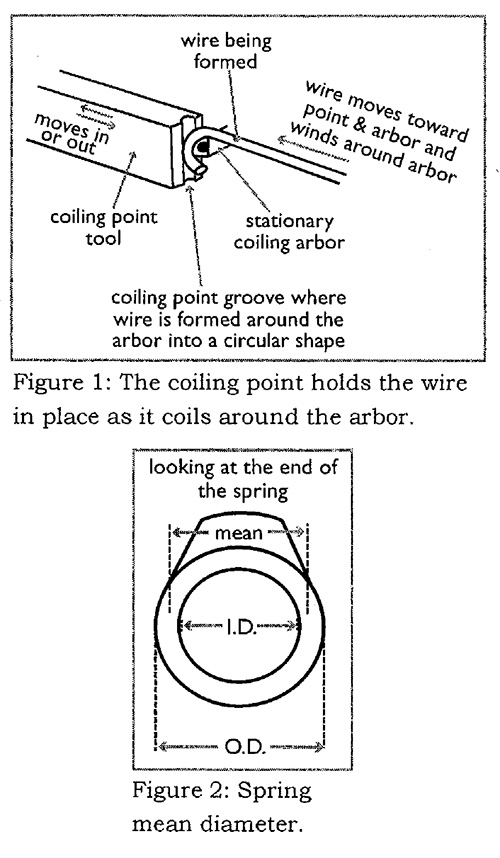- A spring is a torsion bar.
- A torsion bar can be twisted or bent.
- The spring Rate is determined by the cross-section and length.
- A spring is a torsion bar wrapped into a helix, or spiral.
- To make a spring stronger, make the bar shorter (remove coils).
- To make a spring weaker, make the bar longer (add coils).
- As a spring approaches solid height, it will lose coil and the Rate will increase due to the lost material.
So far, the focus has been only on the bar. Now we will discuss a spring property that has an impact on many other factors. This is the spring “index.” pieces of information, we can find out how tightly the spring is coiled. To do that, we need to know all the diameters.
When a spring is coiled, it is wrapped into a circular shape. The spring maker will use a tool called a “coiling point” to form the diameter of the spring. A simple coiling point is a tool with a groove that holds the wire in place as it coils around an arbor (see Figure 1). The wire is forced between the coiling point and the arbor into a circular shape. The coiling point is held in a tool holder and can be moved in or out as needed to adjust the body diameter of the spring. To make the spring diameter larger, the coiling point is moved away from the wire; to make the spring diameter smaller, the coiling point is moved closer to the wire. The wire is, literally, sandwiched between the coiling part and the arbor.
Let’s assume we need to make a spring that calls for a 2.780 in. O.D. with 0.250 in. wire diameter. With just these two pieces of information, we can find out how tightly the spring is coiled. To do that, we need to know all the diameters.
Or
2. If you know the O.D., subtract one wire size.
Using our previous example, we know the O.D. and the wire diameter. The O.D. was 2.780 in. and the wire diameter was 0.250 in. The “mean” diameter is the 0.250 in. wire diameter subtracted from the 2.780 in. O.D.
Mean diameter = 2.780 in. – 0.250 in. Therefore, the mean diameter of the spring is 2.530 in.
The mean diameter is important because it is
the diameter used in most spring calculations. It is a calculated diameter and cannot be measured directly with a pair of calipers; it must be found mathematically. The O.D. and I.D. are measurable diameters and can be measured with standard calipers.
The “index” of a spring describes how tightly or loosely the spring is wrapped. This information is very useful to the spring engineer because it gives clues to some possible problems with a design. The “index” is found by dividing the mean diameter by the wire diameter. In spring design, the “mean” diameter is symbolized with an uppercase “D” and the wire diameter is a lowercase “d.” Index is a capital “C.”
Or … C = D/d
Using our known mean and wire diameters:
C = 2.530 / 0.250
C = 10.12
This means the “wrap” of the coils is about 10 times greater than the wire size.
Next time around, we’ll explain why the index is so important to both spring designers and spring makers.

By: Randy DeFord, Engineering Manager Mid-West Spring & Stamping
